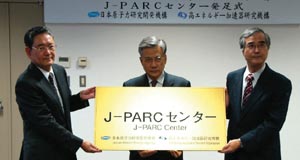The High-Energy Accelerator Research Organization, KEK, and the Japan Atomic Energy Agency (JAEA) have established the J-PARC Center to take entire responsibility for operating the Japan Proton Accelerator Complex (J-PARC), under construction in Tokai, Ibaraki. The centre’s mission will be to operate and maintain the high-intensity proton-accelerator facilities at J-PARC, to pursue Ramp;D for improving performance, and to support all J-PARC users and manage safety issues.

The construction of J-PARC, which started in the spring of 2001, is now in the busiest stage, with about two thirds of the facilities complete. Major components for the proton linac, which accelerates H- beams up to 181 MeV, have been installed in the tunnel, and linac operation should start in December. Magnets for a 3-GeV rapid-cycling proton synchrotron, as well as for a 50-GeV proton synchrotron, are also being installed. The first beam from the 50 GeV synchrotron is expected in 2008.
KEK and JAEA have jointly constructed J-PARC, with each organization taking entire responsibility for the items budgeted to it. However, for the operational stage KEK, and JAEA have recently established that J-PARC will be controlled and managed by a single organization, the J-PARC Center.
The J-PARC Center was established in February, ready for the start-up of the linac at the end of 2006, and has begun partial operation with 62 staff and J-PARC director, Shoji Nagamiya. There are three divisions at this stage, covering accelerators, safety and administration. The number of staff will increase to around 330 by 2008 in about 10 divisions.
Many places in Japan, including the central government, prefecture and local government, and other research organizations, have congratulated the J-PARC Center. In its meeting in February, the International Advisory Committee of J-PARC, chaired by J W White of Australian National University, stated: “We recommend that the vision of the J-PARC Center be that of a centre of excellence in quantum-beam science for a broad user community and an ‘in house’ scientific community of such quality as to achieve international respect for their science.”







